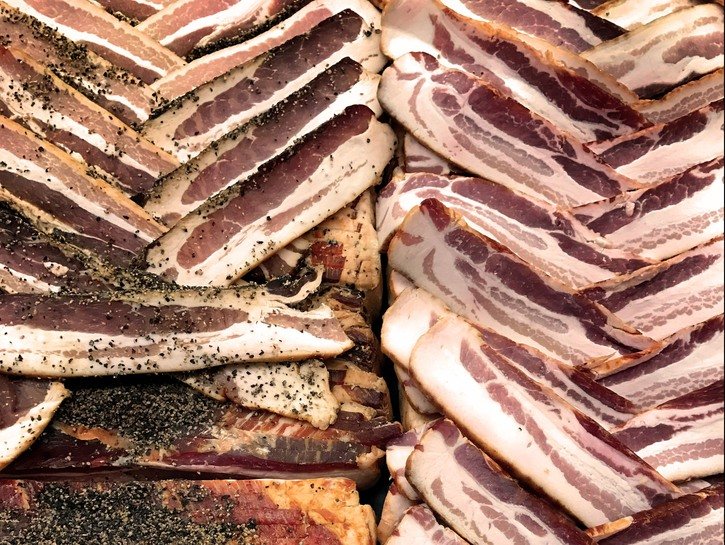Bacon’s great on its own and even better when paired with eggs or on top of a pizza, regardless of whether it’s crispy or chewy. That being said, there’s more than your generic grocery store brand of “bacon-cut bacon.” Here are our favorite bacon types and substitutes that all deserve their time in the spotlight (and on the dinner plate).
Speck
Distinctively juniper-flavored, speck is Italian bacon. It is made from deboned pork legs and cured in various spices like garlic, nutmeg, and of course, juniper. When it’s all spiced and cooked, speck looks a lot like regular bacon, but the specific spices give it a unique flavor.
Gypsy Bacon
This old-fashioned form of bacon is cured with garlic and paprika giving it a distinctively spiced flavor. True to the gypsy nature, this bacon is ideal for campers and is often speared with a stick and cooked over open flame.
Duck Bacon
Cut from the breast of Moulard ducks, duck bacon is yet another alternative to pork. The meat is rubbed with salt and sugar and then smoked. It comes in the same thin slices as pork bacon and has the same meaty flavor without the fat.

Tempeh
Originally from Indonesia, Tempeh is a soy product that is a staple source of protein in many Asian cultures. It is made from the natural fermentation that binds soybeans into a protein-packed loaf. This loaf is in the exact shape of uncut bacon, and, when sliced thinly and fried up with some black pepper and smoked paprika, turns out closer to bacon than you’d think.
Coconut Bacon
Even vegans can enjoy the salty deliciousness of bacon with this healthy bacon alternative. Coconut flakes are coated with maple syrup, tamari, and liquid smoke to make a taste that is surprisingly similar to traditional bacon.
It is baked instead of fried but still has a bacon-like texture.
Pancetta
Pancetta is most often cured in salt, nutmeg, pepper and fennel. Unlike traditional bacon, pancetta is unsmoked. It can be rolled or cut into slabs and adds an enticing pork flavor to pasta without submitting it to the smokiness of average bacon.
Slab Bacon
Slab bacon is not cut into the traditional thin and crispy bacon slices, but instead comes in thicker blocks or slabs. It comes from the same place as traditional bacon—the pork belly—and is cured and smoked.
This kind of bacon is most often used to flavor soups and stews.

Seitan
Known as wheat meat, seitan is made from the protein found within wheat. Wheat consists of high-protein gluten that is used by many vegetarians as a mock meat.
It has the ability to adapt to both the texture and flavor of meat.
Lamb Bacon
We’ve learned that the word ‘bacon’ is not reserved for only pork. You can make bacon out of seemingly anything, and lamb is no exception. Salted, smoked, and sliced, lamb bacon should be on every bacon connoisseur’s menu.
Beef Bacon
Beef bacon is a fatty cut of meat that is salted and then smoked. It is cut into thin slices and could easily pass as pork bacon, but it is up to 90% leaner.
If there is a downside to the culinary art that is bacon, it is how fatty it is, but beef bacon lets you enjoy the salty slices of heaven without clogging your arteries.
Elk Bacon
Elk bacon may be 50 percent pork fat, but that extra fat infuses extra flavor into the already tasty elk meat. It is cured with a variety of spices including black pepper and is a haughtier version of typical bacon.
Soy Protein Bacon
This bacon substitute is perfect for vegetarians. It is low in saturated fat and is naturally cholesterol-free. It has that smoked bacon taste without the fat of real meat, and it’s often sold as “Veggie Bacon Strips” or something similar.
Canadian Bacon
This type of meat looks more like cooked ham than bacon to many Americans, but it is cured and salted making it a delectable type of bacon. It comes from the leaner back strips of pork and is slightly sugared.
Canadian bacon is a popular pizza topping and is also popular in omelets and other leaner breakfast choices.

Irish Bacon
Ireland and Canada may be an ocean apart but that gap has been closed by a culinary bridge of bacon. Irish bacon is from the back meat of a pig and is thick and tender, not crispy.
What makes it different from Canadian bacon is that the Irish version usually has a layer of fat around the meat.
Peppered Bacon
Peppered bacon is prepared similarly to traditional bacon, but it packs an extra flavorful punch. Usually cut into thick slices, peppered bacon is exactly what it sounds like.
Crushed black pepper adds extra flavor that enhances any meal, any time of the day.

Venison Bacon
Venison bacon is rarely found in supermarkets but can be easily made at home. It is a mixture of deer meat, pork meat, and pork fat and makes a flavorful substitute for traditional pork bacon.
Turkey Bacon
Turkey bacon is served as a low-fat bacon alternative but has the same salty flavor of regular bacon. It’s great in BLTs and omelets and is a tasty substitute for those who can’t eat pork due to religious or dietary reasons.
